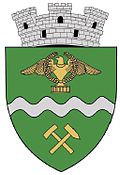Zlatna
|
Zlatna Kleinschlatten Zalatna |
||||
|
||||
| Basic data | ||||
|---|---|---|---|---|
| State : |
|
|||
| Historical region : | Transylvania | |||
| Circle : | Alba | |||
| Coordinates : | 46 ° 7 ' N , 23 ° 13' E | |||
| Time zone : | EET ( UTC +2) | |||
| Height : | 423 m | |||
| Area : | 240.65 km² | |||
| Residents : | 7,490 (October 20, 2011) | |||
| Population density : | 31 inhabitants per km² | |||
| Postal code : | 516100 | |||
| Telephone code : | (+40) 02 58 | |||
| License plate : | FROM | |||
| Structure and administration (as of 2016) | ||||
| Community type : | city | |||
| Structure : | 18 districts / Katastralgemeinden: Fenes , Galaţi , Valea Mică , Pătrângeni , Podu lui Paul , Parau Gruiului , Pirita , Trâmpoiele , Dealu Roatei , Izvoru Ampoiului , BOTESTI , Budeni , Dumbrava , Dobrot , Rusi , Vâltori , Runc , Suseni , Fântânele | |||
| Mayor : | Silviu Ponoran ( PNL ) | |||
| Postal address : | Str. Calea Moților, no.12 loc. Zlatna, jud. Alba, RO-516100 |
|||
| Website : | ||||
Zlatna ( German Kleinschlatten ; Hungarian Zalatna ) is a small Romanian town in the Alba district in Transylvania .
Geographical location
The place is located in the Trascău Mountains and consists of the core town and the 18 villages: Boteşti, Budeni, Dealu Roatei, Feneş, Fântânele, Trâmpoiele, Izvoru Ampoiului, Galați, Presaca Ampoiului, Pătrângeni, Podu lui Paul, Părăuita Grui, Runc, Ruși, Suseni, Valea Mică and Vâltori.
history
In the former Roman province of Dacia the place was called Ampelum and has been documented since 158 or 1201 according to various sources. The place name, which is derived from the Slavic word zoloto and means "gold", was changed into Romanian, Hungarian and German. The place was first mentioned in 1338 under the name Zlatna . In 1895, the Alba Iulia – Zlatna narrow-gauge railway was put into operation. This was replaced in 1984 by a standard gauge railway.
In 1782 the Austrian mineralogist and natural scientist Franz Joseph Müller von Reichenstein discovered the element tellurium while investigating gold ores from the Mariahilf mine near Zlatna. The city is therefore the type locality for the Tellurium today .
In 1968 Zlatna became a town.
population
The population of the municipality developed as follows:
| census | Ethnic composition | |||||||
|---|---|---|---|---|---|---|---|---|
| year | population | Romanians | Hungary | German | other | |||
| 1850 | 8,141 | 6,941 | 605 | 359 | 236 | |||
| 1941 | 9,485 | 8,952 | 344 | 83 | 106 | |||
| 1977 | 10,027 | 9,689 | 186 | 9 | 143 | |||
| 1992 | 9,391 | 9,032 | 112 | 13 | 234 | |||
| 2002 | 8,612 | 8,367 | 57 | 4th | 184 | |||
| 2011 | 7,490 | 6,710 | 30th | 4th | 746 (344 Roma ) | |||
Attractions
- The Adormirea Maicii Domnului Orthodox Church , built in 1424, renovated in 1696 and 1744, is a listed building.
- The Sf. Nicolae și Nașterea Maicii Domnului Church, built between 1770 and 1780, is a listed building.
- The Roman Catholic Church Sf. Ioan din Nepomuk , erected in 1752.
- The reformed church built in the 19th century.
- The city's house of culture ( Casa de Cultură )
- Zlatna is overlooked in the northeast ( ⊙ ) by an approximately 220 meter high chimney, which is connected to a now disused copper smelter with a flue gas pipe.
Personalities
- Johann Georg Hoffinger (1756–1792), doctor, mountain physician and member of the academy of scholars " Leopoldina "
- Petru Dobra (1817–1849), revolutionary and companion of Avram Iancu
- László Lukács (1850–1932), politician, finance minister and Prime Minister of Hungary in 1912/13
Web links
Individual evidence
- ↑ 2011 census in Romania ( MS Excel ; 1.3 MB)
- ↑ Mayoral elections 2016 in Romania ( MS Excel ; 256 kB)
- ↑ Information on the city's website , accessed on February 29, 2016 (Romanian).
- ↑ a b c Heinz Heltmann, Gustav Servatius (ed.): Travel Guide Siebenbürgen. Kraft, Würzburg 1993, ISBN 3-8083-2019-2 .
- ↑ Census, last updated October 30, 2008 (Hungarian; PDF; 1.1 MB)
- ↑ Information on the Orthodox Church at biserici.org accessed on March 1, 2016 (Romanian)
- ↑ a b List of historical monuments of the Romanian Ministry of Culture, updated 2010 (PDF; 7.10 MB)
- ↑ Information on the Orthodox Church at biserici.org accessed on March 1, 2016 (Romanian)
- ↑ Information on the Roman Catholic Church at biserici.org accessed on March 1, 2016 (Romanian)
- ↑ Information on the Reformed Church at biserici.org accessed on March 1, 2016 (Romanian)
- ↑ Pictures of the fireplace with a view of the small town 1 2
- ↑ Ioan Galdea: Zlatna celebrates at dacoromania-alba.ro (information on Petru Dobra) accessed on March 1, 2016 (Romanian)






